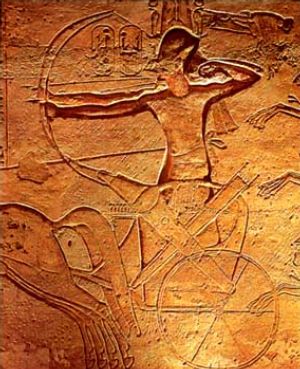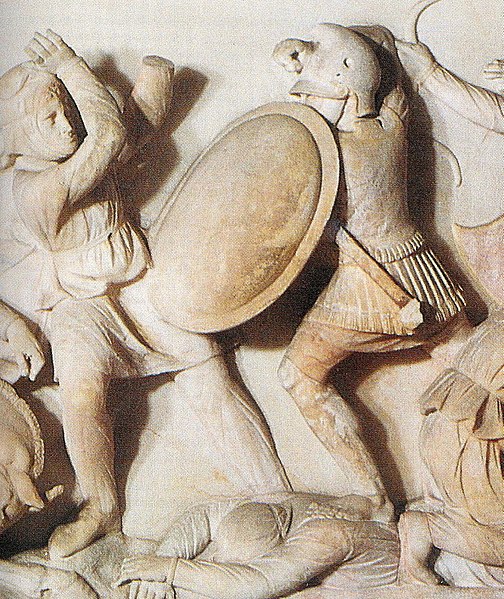Nese lufta e Trojes ka qene ndermjet viteve 1230-1170 BC atehere:
Me pak fjale, shprengulja ose dyndja e madhe frigje ngjau rreth 1050-800 BC me nje diference 100-150 vjecare pas Luftes se Trojes (1230-1170). Homeri permend si frigjet, ashtu dhe paionet e dardanet si aleate te trojaneve. Si rrjedhim hapen keto mundesi dhe pyetje:
Cambridge ancient History volume III ,part 1 , "The pehistory of the Balkans":
The name 'Illyrian' which the Greeks applied to their neighbours in the north-west area seems to have originated in a tribe of 'Illyrii' resident in classical times near the mouth of the Drin (Drilon) and described as Illyrii proprie dicti. At some time they were probably the southernmost outliers of the tribes which held the Zeta valley (borders between Albania and Montenegro) , and as such they may have been the immediate neighbours of Greek-speaking tribes in the Bronze Age. If so, they were leap-frogged by the Taulantii, to whom the Illyrian name was then extended. The movements of these tribes may be reflected in a genealogy which made Cyclops the father of Illyrius (Appian, Illyr. 2), an indignity indicating a Greek invention perhaps conceived at Epidamnus. The children of Illyrius included Taulas, ancestor of the Taulantii, Encheleus, ancestor of the Encheleae who lived north of Lake Ochrid and held the upper valley of the Drin, and Partho, ancestress of the Parthini who held the middle and upper valley of the Shkumbi. It is likely that all these tribes moved into these habitats in the late eleventh or early tenth century B.C. Their natural routes of entry from the north were via the Zeta valley to Scodra and via the White Drin region to Kukes. Hill-fortresses near Scodra and near Kukes have been associated with incoming Illyrian tribes
When the Phrygians left Macedonia, the country became open to invasion. The next period, c. 800—700 B.C., was marked by a great expansion of Illyrian tribes. In the west they took possession of the coastal plain of Malakaster, and Illyrian raiders penetrated into central Epirus. The lakeland fell under the control of Illyrians probably from Dardania; their graves were less rich than those of their predecessors. Upper and Lower Macedonia alike (with the exception of Pieria) were taken over by groups of Illyrians who came probably from central Yugoslavia and had their own forms of the Glasinac culture. The centres of their power in Lower Macedonia were at Vergina by the Haliacmon and on both sides of the Vardar by Gevgheli. Other Illyrians took control of the middle Strymon valley and the coastal plain, including the site of Amphipolis.
[...] The authors of the changes which we have noted in the lakeland, west Macedonia and now the strategic area of the lower Vardar were certainly Illyrians who came not from Illyris but from the great reservoir of Illyrian peoples in what is now central Yugoslavia. The most famous cemetery there is at Glasinac, with more than 20,000 tumuli, in use from the Early Bronze Age (above, p. 600). The expansion of the Illyrians was on a very large scale: not only through the lakeland and via Pelagonia into the Haliacmon valley and the whole of western Macedonia, but also into the middle Vardar valley, where bronze ornaments and pendants have been found at Kumanovo, Vucedol near Skopje, Radanja near Stip and Titov Veles. The traces of other Illyrian settlers have been found in western Bulgaria, in Romania, north of the Danube, in the middle Strymon valley, in the region of Lake Doiran and near the site of Amphipolis .
1. Frigjet sikunder e thote teksti i mesiperm nuk jane dyndur si rezultat i 'ekspansionit ilir'
por me gjase frigjet e nuhaten mire vakumin e krijuar nga renia e Perandorise Hitite
2. Nese frigjet permend si aleate te trojaneve pra 150-200 vjet para dyndjes zyrtare (1050-800 BC), atehere c'data ose c'fakte mund te jepen mbi nje vendosje me te hershme te tyren (si dhe te paioneve e dardaneve)?
3. Nje agjitator grek postonte disa faqe te perzhgjehura te filan indo-europianisti i cili thoshte se Homeri (rapsodet homerik) kane perdorur anakronizma, gjegjesisht ata e kane inkorporuar gjendjen demografike te shekullit te IX, si gjendje demografike e kohes se luftes se Trojes:

Po te mund t'u jepnim pergjigjje e kunderpergjigje ketyre pohimeve, besoj qe do te zbardhnim nje pjese te mire te enigmes Trojane...
Zeus10, Socio, Kolvior pres ndonje opinion nga ana juaj...!?








